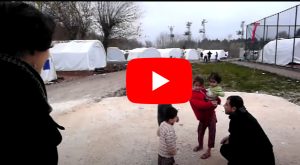In April 2015, TAMTAM traveled to Diyarbakir in Kurdistan (South Turkey) where we played performances of To Have Or Not To Have and conducted workshops. We also visited a Syrian refugee camp about which this video was made. Below is a report.
There is a lot of poverty in Diyarbakir. People who live in half-destroyed houses with far too large families. Even in the center the decay is visible. Turkey is a rich country, but Kurdistan is kept poor. That can be seen everywhere. The power regularly goes out and the entire city is in the dark for hours. Shopkeepers try to illuminate their shop with candles and oil lamps. There are many quite old cars with handcarts and motorcycles mixed with handcarts in between, piled up high with merchandise.
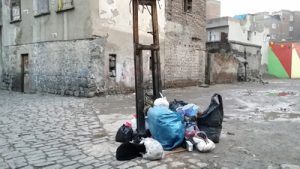
In front of the bakery a large group of Roma women are sitting on the sidewalk with the bread from the previous day they just received. Beggars everywhere. Children know 3 phrases of English: What You Name? Where You From? Gimme Money!
The theatre
In the theatre where we play (actually an old cinema) the air conditioning doesn’t work, the windows can’t open it smells unbelievably unhealthy. Formaldehyde? After two days of working there we have a sore throat and irritated sinuses.
The borrowed prehistoric lighting installation has been tinkered together with loose cables and one of the 5 spots only works once in a while, after it has been hit. A number of chairs are broken, part of the linoleum on stage is gone.
Anyway, it works more or less and it is our specialty to work with found objects and also with found situations, and together with the helpful technician we make the best of it. In the end, the show looks actually pretty good!
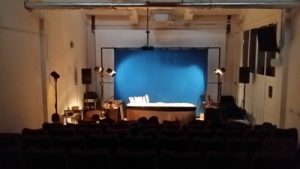
We are lucky that the power failure does not come during the performances but just after we have finished taking the set down and packing everything. It is then pitch dark in the entire building and there is no emergency lighting or emergency exit. With the light of telephones we look for the exit. This happens regularly, the interpreter tells us. It turns out that the very outdated energy system cannot withstand a population of 1.4 million inhabitants with around 14,000 refugees around it.
Despite all the poverty and adversity, the atmosphere is combative. And the public eager. They want to experience new culture from the west. The comparison with Eastern European countries just after the fall of communism is compelling.
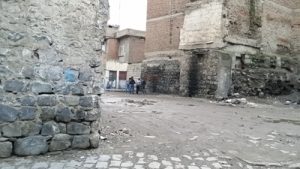
But wait a minute… Isn’t this country one of the booming economies and it so desperately wants to join the EU? Why all this poverty and inadequacy?
According to the people of Diyarbakir, which is 90% Kurdish, the government in Ankara knowingly disadvantages the Kurds to ensure that they do not become too strong and that their desires for self-government stand no chance.
Education is in Turkish, while the main language is Kurdish everywhere. The Kurdish region receives less money than comparable Turkish regions. There is hardly any money for road maintenance or health care. The airport, actually a military base, is not allowed to be expanded and looks ragged. Our suitcases with the show in them do not come with our plane. That seems to be quite common, because it “only goes to Kurdistan. The customs at the airport in Istanbul ask if we are tourists. If we answer affirmatively for the sake of convenience, we get an incredulous look: why in God’s name are we going to Diyarbakir? We’re invited! Shaking his head, he returns the passports with a pitying look to the colleagues.
The performances
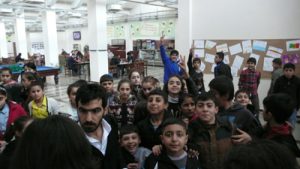
In Diyarbakir we play three performances of To Have Or Not To Have. All three packed with audience. Beforehand, the audience gathers impatiently in front of the door. We give a short introduction there in which we explain what object theater is and that it concerns a performance without text. They come in very quiet and look concentrated. We are used to a lot of laughter, especially in the second part of the performance in which pliers and a mole trap fight a mini war in a fairly cartoonish style. Complete with castles and medieval-looking battles.
It’s kind of a chronicle of jealousy and greed: The flyer says, “In the beginning there was nothing, then there was something, and then everyone wanted to have it.” But here, with a war being fought around the corner, the mood is serious and at most there is an occasional smile.
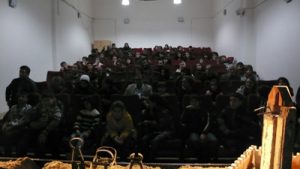
As a performer you always feel the mood and energy of the audience. Here we share with the public the misunderstanding of war. Playing the last scene, in which the two fighters die, is hard for us. There are real deaths around the corner and everyone knows relatives in Syria or Iraq who have been killed in the war that has gone on for far too long. When it turns out at the end that the main characters fought and died for nothing, an approving sigh of relief goes through the hall.
Especially the last show with adults only is very intense and we are playing with a lump in our throats. Afterwards, many spectators come to shake our hands and thank us, but without the usual cheerfulness…
One of the reasons we said yes to this project is that we can give a workshop to theatre makers who work in Diyarbakir with children from poor neighbourhoods and to artists who volunteer in the refugee camps for refugees expelled from Syria. Around Diyarbakir, 14,000 refugees live in makeshift camps. Yazidis, known for their sacred mountain from where they were massacred by IS, and residents of Kobane who fled the siege. The aim is to teach them how to create performances with the children with found objects and worthless materials, because that is very accessible in the camps.
In addition to a lack of food, clothing and warmth for the winter, there is also an enormous need for culture there. People are waiting for better times and need positivity and perspective.
The 16 participants are eager to learn something and participate fanatically in the assignments in which they have to create scenes with objects they have brought along. During the explanation, everything is eagerly noted and questions are asked. The short scenes that they make at the end of the day are therefore strongly linked to the feeling that you feel everywhere in the city. On the one hand depressed because of the near war and the great sadness, but on the other hand combative, socially and politically involved.
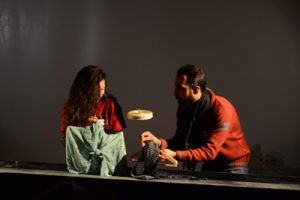
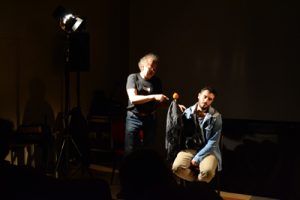
The situation of Kurdish refugees from Syria is shocking. In total there are around 130,000 refugees from Kobani and from the area of the Yazidis. They are spread over 7 cities in southern Turkey. Many camps are run by the Kurdish organizations. There are 3 camps with a total of almost 9000 refugees who are the only ones recognized as refugees by the Turkish government. The other camps have to be financed by the Kurdish organizations but that hardly works. For example, Diyarbakir officials are giving up a large part of their salary, but that is not enough with winter approaching.
To the camp
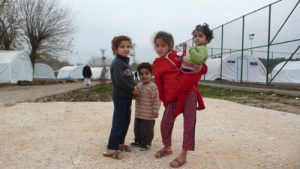
On our way to Turkey we already thought that, if we going to work with the volunteers, we would also like to visit a camp to play for the residents.
That turns out to be a very Western idea, something like that cannot just happen. The people there are very suspicious and certainly don’t want strangers doing missionary-style charities or sensationalist journalism. Within the camps, the refugees have organised themselves and everything is decided in extensive meetings together with the local Kurdish organisations. They are also suspicious of any expression of Islam: a dancer who had a dance with bowing movements in it was ridiculed because it resembled a Mohammedan prayer position.
We are briefed by two young women, participants in the workshop, who volunteer twice a week in the largest camp. They tell us that we definitely can’t just go there with a performance. Menap Seker, one of the coordinators from Diyarbakir, promises to take us with him. But we are urged to be careful.
It is decided to go with a small delegation.
We travel with to people from the cultural organisation that invited us, Johan Kuiper, who coordinated the project from the Netherlands, and visual artist Lies Kortenhorst, who is also giving a workshop on community art with us. Menarp accompanies us. Over the past few days, talking spontaneously, the idea has arisen to start a charity in Holland, and we want to talk in the camp about what is the greatest need and where the sensitivities lie. It is not clear whether we will play.
We drive to the camp with two cars.
It is the first time that we are outside Diyarbakir. Poverty is already noticeable in the city, outside it is even worse. After the flats of the suburbs we arrive in the countryside. Wrecked houses, rickety shelters on a barren plain with rubbish everywhere. A blackened transformer house with a tangle of cables towards it explains the power cuts. Everything points to a country just barely keeping its head above water.
The taxi we’ve been driving in all week is already held together with tape, but the private car of the husband of our hostess Övgü Gökçe is really falling apart. Getting out and in is a whole ritual of first opening that door, then clicking everything open and shut three times, then opening that other door from the outside, the other door has to be handled like cracking a safe, with a lot of feeling, moving and clicking the handle in a special way. Inside, everywhere loose parts and non-working gadgets. Windows that only open painfully slowly. Symbolic for the state of Kurdistan.
Then come we arrive at the camp. (See the video )
We drive through a concrete tunnel under the road and suddenly we are standing in front of the gate of what was once a recreation park with a sports field. Now there is a container at the gate with a dozen shabbily dressed men by it.
After some consultation we can enter. And then we drive past endless rows of tents with laundry hanging to dry, children with smaller children on their arms, women in received clothes. And here and there men too. There are more than 4000 people in this tented camp, of which 800 are young people between the ages of 12 and 18 and 800 children under the age of 12.
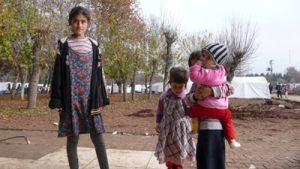
We drive back and forth, there is another consultation, and then we arrive at a small office, improvised in a changing room of a tennis court.
Slave market
After we have been welcomed there with tea, we start a conversation about the technical aspects of the aid, especially in Turkish. Part of the conversation is translated. For example, the story about 6000 women kidnapped by IS who are sold to IS fighters on the slave market in Mosul for €10, a story you don’t hear about in the media. And the complaint about the lack of support from the Turkish government.
After a while it is only in Turkish and there is heated discussion. We decide to go outside where a number of curious children and young people have gathered in front of the door.
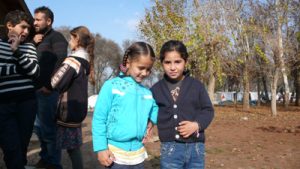
We may not have taken a performance, but we did take into account that we might be able to do something small for a few children at an unguarded moment. And that’s now. In our coat pockets we carry a few plastic bags, a piece of shiny wrapping paper, a kazoo, a mouth harp, and we also took the guitar with us but left it in the car. We start very carefully to make a puppet out of a shopping bag and bring it to life. Encouraged by the positive reactions, we both start playing and improvising, and when the kazoo is brought out and we play a funny scene together, the first laugh comes from the clump of children that quickly grows into a large group. They soon are surrounded by adults and teenagers who also laugh and take pictures with their mobile phones.
When the guitar is added, the group becomes too large and we are dragged into a large empty tent intended for gatherings. There we play short scenes for over half an hour that we improvise on the spot with music and even a song in between. Not exactly what we normally play, but exactly what they need here and what can be done with the minimum of resources. Our goal, to do something that is accessible for the children to do themselves, succeeds wonderfully: in no time children are fiddling around with plastic bags and making kazoo sounds with wrapping paper between their fingers.
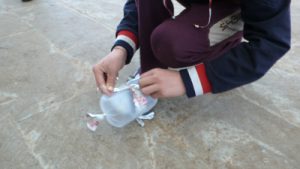
A boy proudly shows off a creature he made with an inflated bag and some gift wrap bows. It is weird to sees a teenager who makes two holes in a gift-wrapping bag with his teeth and then taps me on the shoulder to show that he has made a kind of terrorist hood, but with cheerfully shining stars. I am initially shocked by the association with war and terrorists but his friend cheerfully yells: Hey Superman! Superman spreads his arms to fly away.
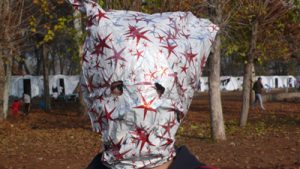
Of course they would like that here. A superman who solves it all for a while and preferably they would probably like to fly away themselves. What they have been through is unbearable. Seeing family members murdered or raped or being raped or abused themselves. It’s so incomprehensible that you can’t imagine it.
When we say goodbye, we are hugged, touched and they shout “bye bye” and “thank you”. We may have been able to bring a very small drop drop in the ocean.
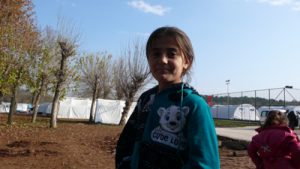
It’s tough to get out of there again and sit down to a nice meal in a warm and clean building while it starts to rain outside and you know they’ll be sitting there in the mud. It produces a dull feeling of powerlessness and only hours later, when I Whatsapp to Holland, the tears come.
Most will not just sit there for a while, but often for a longer period of time. Later we speak to someone who fled earlier and lived in a tent for a year and a half.
Apart from all the horrors of the war they have already experienced, they are now entering winter. And they are definitely not prepared for that.
Most pressing is the fact that we realize that they are ordinary people who, just like us, had an ordinary life, a job, a house, a car in front of the door, a computer on a desk and just simple moments of happiness and they were expecting a bright future. But from one day to the next they found themselves in a camp with a given tracksuit and shoes that are too big. And that they will be there for years to come.



